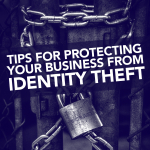 Identity theft is big business and can have a significant impact on your organization should you fall victim to it. Scammers are finding new ways every day to impersonate businesses, while hiding behind technology to avoid being tracked and prosecuted. These scammers commit business identify theft in many ways, and keeping up with it can be daunting. Read on for some of the most common ways impostors can steal your identity.
Identity theft is big business and can have a significant impact on your organization should you fall victim to it. Scammers are finding new ways every day to impersonate businesses, while hiding behind technology to avoid being tracked and prosecuted. These scammers commit business identify theft in many ways, and keeping up with it can be daunting. Read on for some of the most common ways impostors can steal your identity.
Online Impersonation: Scammers impersonate a business on social media – especially in Facebook buy, sell, and trade groups – to hijack prospective customers and ultimately rip them off.
Financial and Tax Fraud: Scammers commit financial fraud by opening lines of credit, obtaining credit cards, and securing loans in a business’s name. They may impersonate a business by filing fraudulent tax returns and obtaining refunds.
Website Defacement: This type of attack changes the visual appearance of a website or web page. These are typically the work of sophisticated defacers, who break into a web server and replace the hosted website with one of their own.
Trademark Ransom: Scammers might register a business’s name as an official trademark and then demand a ransom for release of the trademarked business name.
HOW TO FIGHT BACK
Wondering what preventative steps business owners can take to avoid falling victim to business identity theft? According to the www.businessidentitytheft.org, the following strategies can be useful:
Deal with Expiring Domain Names: If your business owns a domain name that is expiring and is not going to be renewed, delete all information from online applications such as email, calendars, and Google apps associated with the domain. This will prevent anyone who later purchases the domain from accessing online account credentials.
Monitor the Internet Vigorously: Utilize Google Alerts to proactively search the internet for references to your business. The service allows you to quickly set and receive email alerts of search results and news stories that match the search terms you specify.
Use Domain Privacy Services: Scammers can utilize the public Whois database, which provides information regarding the registered owner of an internet domain name (including owner name, address, email, and telephone number) that can then be used in a variety of scams. If your business owns one or more internet domains and/or maintains a website, consider using a domain registration privacy service that replaces your business information in the Whois database with that of the domain privacy service (proxy information) to better protect your personal information.
Be Diligent and Always on Alert for Impostors on the Web (and Make your Customers Aware): Some business impostors establish a page in your business’ name on popular social networking sites like Facebook or LinkedIn. These pages can include your business’ logo, images, and information, but provide alternate contact information. Monitor local Facebook buy, sell, and trade groups for individuals impersonating your business to steal customers. Businesses should also consider including safety policies in customer-facing emails, social media accounts, and websites to inform customers about what to look for if scammers do target your company.
Use Image Recognition Tools: There are image recognition tools in the marketplace that can be used to proactively crawl the internet, searching for images using your company’s logo or other trademarked images.
Unfortunately, we’ve seen an uptick in scams during the COVID-19 pandemic, as dishonest contractors prey on the fear of unsuspecting businesses and homeowners during these uncertain times. These impostors make our whole industry look bad.
If you have not developed a strategy for protecting your business against identity theft, consider putting a plan in place to help mitigate risk and protect your business from a potentially devastating financial threat.
(Reprinted with permission from NADCA.com)





